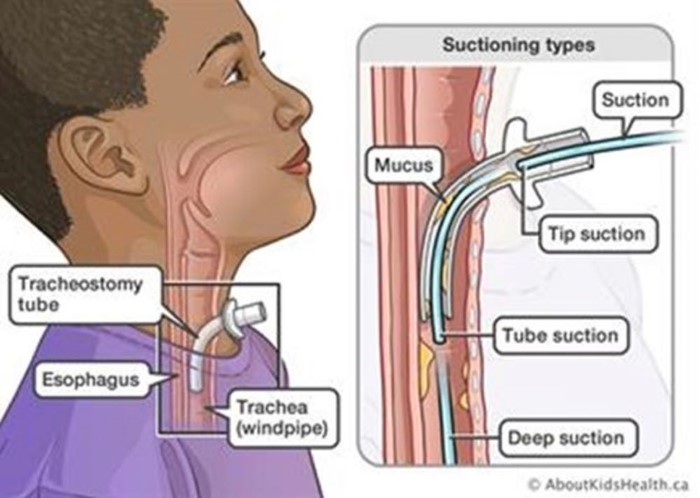In caring for a client who requires seizure precautions, the practical nurse (PN) should ensure the ready availability of equipment to perform which procedure?
Suction the trachea.
Insert a urinary catheter.
Apply soft restraints.
Insert a nasogastric tube.
The Correct Answer is A
- Seizure precautions are measures taken to protect a client who is at risk of having a seizure, which is a sudden and abnormal electrical activity in the brain that can cause changes in behavior, movement, sensation, or consciousness. Seizure precautions include providing a safe environment, monitoring the client's vital signs and neurological status, administering anticonvulsant medications, and documenting the onset, duration, and characteristics of any seizure activity.
- One of the potential complications of a seizure is aspiration, which is the inhalation of foreign material into the lungs, such as saliva, vomit, or food. Aspiration can cause choking, pneumonia, or respiratory distress. To prevent or treat aspiration, the practical nurse (PN) should ensure the ready availability of equipment to perform suctioning of the trachea, which is the tube that connects the mouth and nose to the lungs. Suctioning of the trachea involves inserting a catheter through the nose or mouth into the trachea and applying negative pressure to remove any secretions or debris from the airway.
- Therefore, option A is the correct answer, while options B, C, and D are incorrect.
Option B is incorrect because inserting a urinary catheter is not related to seizure precautions or aspiration prevention.
Option C is incorrect because applying soft restraints may not be necessary or appropriate for a client who requires seizure precautions, as they may interfere with the natural movements of the seizure or cause injury to the client.
Option D is incorrect because inserting a nasogastric tube is not related to seizure precautions or aspiration prevention.

Nursing Test Bank
Naxlex Comprehensive Predictor Exams
Related Questions
Correct Answer is A
Explanation
A. Correct. The nurse should initiate continuous cardiac monitoring because a magnesium level of 2.7 mEq/L indicates hypermagnesemia, which can cause cardiac dysrhythmias, hypotension, and bradycardia.
B. Incorrect. The nurse should not administer potassium chloride to a client who has hypermagnesemia because it can worsen the condition by increasing the intracellular magnesium level and decreasing the serum calcium level.
C. Incorrect. The nurse should not provide a diet rich in legumes, nuts, and green vegetables to a client who has hypermagnesemia because these foods are high in magnesium and can increase the serum magnesium level.
D. Incorrect. The nurse should not monitor the client for tetany because tetany is a sign of hypomagnesemia, not hypermagnesemia. Hypomagnesemia can cause neuromuscular excitability, muscle spasms, and positive Chvostek's and Trousseau's signs.
Correct Answer is D
Explanation
A. Instructing the client about the importance of regular medical appointments is important but not the priority because it is a secondary prevention strategy that aims to detect and treat any complications or changes in the client's condition early. The client should have regular follow-up visits with an endocrinologist, a diabetes educator, an ophthalmologist, a podiatrist, a dentist, and other health care providers as needed.
B. Encouraging the client to participate in daily exercise is important but not the priority because it is a tertiary prevention strategy that aims to reduce disability and improve quality of life for clients with chronic conditions. Exercise can help lower blood glucose levels, improve insulin sensitivity, reduce cardiovascular risk factors, enhance mood, and promote weight management for clients with type 1 diabetes mellitus. The client should consult with their health care provider before starting an exercise program and follow safety guidelines such as checking blood glucose levels before and after exercise, wearing appropriate footwear and clothing, carrying a source of fast-acting carbohydrate, and staying hydrated.
C. Explaining proper foot care techniques to the client is important but not the priority because it is a tertiary prevention strategy that aims to prevent or minimize complications such as foot ulcers, infections, and amputations for clients with type 1 diabetes mellitus. Foot care includes inspecting feet daily for any injuries or abnormalities, washing feet with mild soap and warm water, drying feet thoroughly especially between toes, applying moisturizer to prevent dryness and cracking, trimming toenails straight across and filing edges smooth, wearing clean cotton socks and well-fitting shoes, avoiding walking barefoot or exposing feet to extreme temperatures or pressure, and seeking medical attention for any foot problems.
D. Ensuring that the client understands the medication regimen is the nurse's priority because type 1 diabetes mellitus requires lifelong insulin therapy to maintain blood glucose levels within normal range and prevent complications such as ketoacidosis, hypoglycemia, and organ damage. The client needs to know how to administer insulin injections, monitor blood glucose levels, adjust insulin doses according to carbohydrate intake and physical activity, recognize and treat signs and symptoms of hypo- and hyperglycemia, and store insulin properly.
Whether you are a student looking to ace your exams or a practicing nurse seeking to enhance your expertise , our nursing education contents will empower you with the confidence and competence to make a difference in the lives of patients and become a respected leader in the healthcare field.
Visit Naxlex, invest in your future and unlock endless possibilities with our unparalleled nursing education contents today
Report Wrong Answer on the Current Question
Do you disagree with the answer? If yes, what is your expected answer? Explain.
Kindly be descriptive with the issue you are facing.
